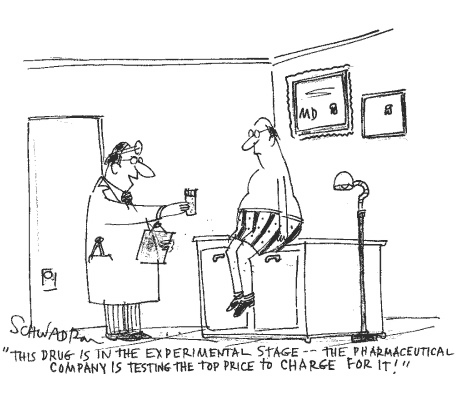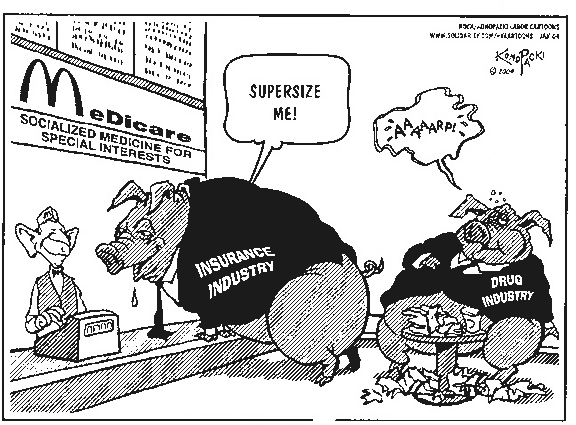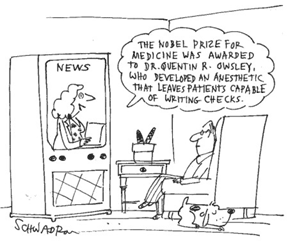|
|
|
Big
Pharma

By Bruce
Levine
Printer friendly version
More than one journalist has uncovered
corrupt connections between the Bush Family, psychiatry,
and Eli Lilly & Company, the giant pharmaceutical
corporation. While previous Lillygates have been more
colorful, Lilly’s soaking state Medicaid programs with
Zyprexa—its blockbuster, antipsychotic drug—may pack the
greatest financial wallop. Worldwide in 2003, Zyprexa
grossed $4.28 billion, accounting for slightly more than
one-third of Lilly’s total sales. In the United States
in 2003, Zyprexa grossed $2.63 billion, 70 percent of
that attributable to government agencies, mostly
Medicaid.
Historically, the exposure of any single Lilly
machination—though sometimes disrupting it—has not
weakened the Bush-psychiatry-Lilly relationship. In the
last decade, some of the more widely reported Eli Lilly
intrigues include:
- Influencing the Homeland Security Act to
protect itself from lawsuits
- Accessing confidential patient records for a
Prozac sample mailing
- Rigging
the Wesbecker Prozac-violence trial
A sample of those who have been on the Eli Lilly
payroll includes:
- Former
President George Herbert Walker Bush (one-time member
of the Eli Lilly board of directors)
- Former
CEO of Enron, Ken Lay (one-time member of the Eli
Lilly board of directors)
- George
W. Bush’s former director of Management and Budget,
Mitch Daniels (a former Eli Lilly vice
president)
- George
W. Bush’s Homeland Security Advisory Council member,
Sidney Taurel (current CEO of Eli Lilly)
- The
National Alliance for the Mentally Ill (a recipient of
Eli Lilly funding)
In 2002, British and Japanese regulatory agencies
warned that Zyprexa may be linked to diabetes, but even
after the FDA issued a similar warning in 2003, Lilly’s
Zyprexa train was not derailed, as Zyprexa posted a 16
percent gain over 2002. The growth of Zyprexa has become
especially vital to Lilly because Prozac—Lilly’s
best-known product, which once annually grossed over $2
billion—having lost its patent protection, continues its
rapid decline, down to $645.1 million in 2003.
 At the same time regulatory
agencies were warning of Zyprexa’s possible linkage to
diabetes, Lilly’s second most lucrative product line was
its diabetes treatment drugs (including Actos, Humulin,
and Humalog), which collectively grossed $2.51 billion
in 2003. Lilly’s profits on diabetes drugs and the
possible linkage between diabetes and Zyprexa is not,
however, the most recent Lillygate that Gardiner Harris
broke about Zyprexa in the New York Times on
December 18, 2003. At the same time regulatory
agencies were warning of Zyprexa’s possible linkage to
diabetes, Lilly’s second most lucrative product line was
its diabetes treatment drugs (including Actos, Humulin,
and Humalog), which collectively grossed $2.51 billion
in 2003. Lilly’s profits on diabetes drugs and the
possible linkage between diabetes and Zyprexa is not,
however, the most recent Lillygate that Gardiner Harris
broke about Zyprexa in the New York Times on
December 18, 2003.
Zyprexa costs approximately twice as much as
similar drugs and Harris reported that state Medicaid
programs—going in the red in part because of Zyprexa—
are attempting to exclude it in favor of similar, less
expensive drugs. Harris focused on the Kentucky Medicaid
program, which had a $230 million deficit in 2002, with
Zyprexa being its single largest drug expense at $36
million. When Kentucky’s Medicaid program attempted to
exclude it from its list of preferred medications, the
National Alliance for the Mentally Ill (NAMI) fought
back. The nonprofit NAMI—ostensibly a consumer
organization—bused protesters to hearings, placed
full-page ads in newspapers, and sent faxes to state
officials. What NAMI did not say at the time was that
the buses, ads, and faxes were paid for by Eli
Lilly.
Ken Silverstein, in Mother Jones in 1999,
reported that NAMI took $11.7 million from drug
companies over a three and a half year period from 1996
through 1999, with the largest donor being Eli Lilly,
which provided $2.87 million. Eli Lilly’s funding also
included loaning NAMI a Lilly executive, who worked at
NAMI headquarters, but whose salary was paid for by
Lilly. Though NAMI’s linkage to Lilly is a scandal to
psychiatric survivors—whose journal MindFreedom
published copies of Big Pharma checks to NAMI—the story
didn’t have the widespread shock value that would
elevate it to Lillygate status.
In 2002, Eli Lilly flexed its muscles at the
highest level of the U.S. government in an audacious
Lillygate. The event was the signing of the Homeland
Security Act, praised by President George W. Bush as a
“heroic action” that demonstrated “the resolve of this
great nation to defend our freedom, our security and our
way of life.” Soon after the Act was signed, New York
Times columnist Bob Herbert discovered what had been
slipped into the Act at the last minute and on November
25, 2002, he wrote, “Buried in this massive bill, snuck
into it in the dark of night by persons unknown…was a
provision that—incredibly—will protect Eli Lilly and a
few other big pharmaceutical outfits from lawsuits by
parents who believe their children were harmed by
thimerosal.”
Thimerosal is a preservative that contains
mercury and is used by Eli Lilly and others in vaccines.
In 1999 the American Academy of Pediatrics and the
Public Health Service urged vaccine makers to stop using
mercury-based preservatives. In 2001 the Institute of
Medicine concluded that the link between autism and
thimerosal was “biologically plausible.” By 2002, thim-
erosal lawsuits against Eli Lilly were progressing
through the courts. The punchline of this Lillygate is
that, in June 2002, President George W. Bush had
appointed Eli Lilly’s CEO, Sidney Taurel, to a seat on
his Homeland Security Advisory Council. Ultimately, even
some Republican senators became embarrassed by this
Lillygate and, by early 2003, moderate Republicans and
Democrats agreed to repeal this particular provision in
the Homeland Security Act.
In early 2003, “60 Minutes II” aired a segment on
Lillygate and Prozac. With Prozac’s patent having run
out, Eli Lilly began marketing a new drug, Prozac
Weekly. Lilly sales representatives in Florida gained
access to “confidential” patient information records
and, unsolicited, mailed out free samples of Prozac
Weekly. How did Eli Lilly get its hands on these medical
records? Regulations proposed under Clinton and later
implemented under Bush contained a provision that gave
health-care providers the right to sell a person’s
confidential medical information to marketing firms and
drug companies. Despite many protests against this
proposal, President Bush told Health and Human Services
Secretary Tommy Thompson to allow the new rules to go
into effect.

Perhps the most cinematic of all
Lillygates culminated in 1997. The story began in 1989
when Joseph Wesbecker—one month after he began taking
Prozac—opened fire with his AK-47 at his former place of
employment, killing 8 and wounding 12 before taking his
own life. British journalist John Cornwell covered the
Louisville, Kentucky trial for the London Sunday Times
Magazine, ultimately writing a book about it.
Cornwell’s The Power to Harm (1996) is not only
about a disgruntled employee becoming violent after
taking Prozac, but is also about Eli Lilly’s power to
corrupt the judicial system.
Victims of Joseph Wesbecker sued Eli Lilly,
claiming that Prozac had pushed Wesbecker over the edge.
The trial took place in 1994, but received scant
attention as the public was transfixed by the O.J.
Simpson spectacle. While Eli Lilly had been settling
many Prozac violence cases behind closed doors (more
than 150 Prozac lawsuits had been filed by the end of
1994), it was looking for a showcase trial that it could
win. Although a 1991 FDA “blue ribbon panel”
investigating the association between Prozac and
violence had voted not to require Prozac to have a
violence warning label, by 1994 word was getting around
that five of the nine FDA panel doctors had ties to Big
Pharma—two of them serving as lead investigators for
Lilly-funded Prozac studies. Thus, with the FDA panel
now known to be tainted, Lilly believed that Wesbecker’s
history was such that Prozac would not be seen as the
cause of his mayhem.
A crucial component of the victims’ attorneys’
strategy was for the jury to hear about Eli Lilly’s
history of reckless disregard. Victims’ attorneys
especially wanted the jury to hear about Lilly’s anti-
inflamatory drug Oraflex, introduced in 1982 but taken
off the market three months later. A U.S. Justice
Department investigation linked Oraflex to the deaths of
more than 100 patients and concluded that Lilly had
misled the FDA. Lilly was charged with 25 counts related
to mislabeling side effects and pled guilty—but in 1985,
the Reagan-Bush Justice Department saw fit to fine them
a mere $25,000.
In the Wesbecker trial, Lilly attorneys argued
that the Oraflex information would be prejudicial and
Judge John Potter initially agreed that the jury
shouldn’t hear it. However, when Lilly attorneys used
witnesses to make a case for Eli Lilly’s superb system
of collecting and analyzing side effects, Judge Potter
said that Lilly had opened the door to evidence to the
contrary and ruled that the Oraflex information would
now be permitted. To Judge Potter’s amazement, victims’
attorneys never presented the Oraflex evidence and Eli
Lilly won the case. Later, it was discovered that—in a
manipulation Cornwell described as “unprecedented in any
Western court”—Eli Lilly cut a secret deal with victims’
attorneys to pay them and their clients not to introduce
the Oraflex evidence. However, Judge Potter smelled a
rat and fought for an investigation. In 1997, Eli Lilly
quietly agreed to the verdict being changed from a Lilly
victory to “dismissed as settled.”

Looking back further to 1992, Alexander Cockburn,
in both the Nation and the New Statesman,
was one of the first to connect the dots between the
Bush family and Eli Lilly. After George Herbert Walker
Bush left his CIA director post in 1977 and before
becoming vice president under Ronald Reagan in 1980, he
was on Eli Lilly’s board of directors. As vice
president, Bush failed to disclose his Lilly stock and
lobbied hard on behalf of Big Pharma—especially Eli
Lilly. For example, Bush sought special tax breaks from
the IRS for Lilly and other pharmaceutical corporations
that were manufacturing in Puerto Rico.
Cockburn also reported on Mitch Daniels, then a
vice president at Eli Lilly, who in 1991 co-chaired a
fundraiser that collected $600,000 for the Bush-Quayle
campaign. This is the same Mitch Daniels who in 2001
became George W. Bush’s Director of Management and
Budget. In June 2003, soon after Daniels departed from
that job, he ran for governor of Indiana (home to Eli
Lilly headquarters). In a piece in the Washington
Post called “Delusional on the Deficit,” Senator
Ernest Hollings wrote, “When Daniels left two weeks ago
to run for governor of Indiana, he told the Post
that the government is ‘fiscally in fine shape.’ Good
grief! During his 29-month tenure, he turned a so-called
$5.6 trillion, 10-year budget surplus into a $4 trillion
deficit—a mere $10 trillion downswing in just two years.
If this is good fiscal policy, thank heavens Daniels is
gone.”
 There is one Eli Lilly
piece of history so bizarre that if told to many
psychiatrists, one just might get diagnosed as paranoid
schizophrenic and medicated with Zyrprexa. Former State
Department officer John Marks in The Search for the
“Manchurian Candidate”: The CIA and Mind Control, The
Secret History of the Behavioral Sciences
(1979)—along with the Washington Post (1985)
and the New York Times (1988)—reported an amazing
story about the CIA and psychiatry. A lead player was
psychiatrist D. Ewen Cameron, president of the American
Psychiatric Association in 1953. Cameron was curious to
discover more powerful ways to break down patient
resistance. Using electroshock, LSD, and sensory
deprivation, he was able to produce severe delirium.
Patients often lost their sense of identity, forgetting
their own names and even how to eat. The CIA, eager to
learn more about Cameron’s brainwashing techniques,
funded him under a project code-named MKULTRA. According
to Marks, Cameron was part of a small army of the CIA’s
LSD-experimenting psychiatrists. Where did the CIA get
its LSD? Marks reports that the CIA had been previously
supplied by the Swiss pharmaceutical corporation Sandoz,
but was uncomfortable relying on a foreign company and
so, in 1953, the CIA asked Eli Lilly to make them up a
batch of LSD, which Lilly subsequently donated to the
CIA. There is one Eli Lilly
piece of history so bizarre that if told to many
psychiatrists, one just might get diagnosed as paranoid
schizophrenic and medicated with Zyrprexa. Former State
Department officer John Marks in The Search for the
“Manchurian Candidate”: The CIA and Mind Control, The
Secret History of the Behavioral Sciences
(1979)—along with the Washington Post (1985)
and the New York Times (1988)—reported an amazing
story about the CIA and psychiatry. A lead player was
psychiatrist D. Ewen Cameron, president of the American
Psychiatric Association in 1953. Cameron was curious to
discover more powerful ways to break down patient
resistance. Using electroshock, LSD, and sensory
deprivation, he was able to produce severe delirium.
Patients often lost their sense of identity, forgetting
their own names and even how to eat. The CIA, eager to
learn more about Cameron’s brainwashing techniques,
funded him under a project code-named MKULTRA. According
to Marks, Cameron was part of a small army of the CIA’s
LSD-experimenting psychiatrists. Where did the CIA get
its LSD? Marks reports that the CIA had been previously
supplied by the Swiss pharmaceutical corporation Sandoz,
but was uncomfortable relying on a foreign company and
so, in 1953, the CIA asked Eli Lilly to make them up a
batch of LSD, which Lilly subsequently donated to the
CIA.
The most important story about Eli Lilly
is that Lilly’s two current blockbuster psychiatric
drugs—Zyprexa and Prozac—are, in scientific terms, of
little value. It is also about how Lilly and the rest of
Big Pharma have corrupted psychiatry, resulting in the
increasing medicalization of unhappiness. This diseasing
of our malaise has diverted us from examining the social
sources for our unhappiness—and implementing societal
solutions.
Much of the scientific community now acknowledges
that the advantage of Prozac and Prozac-like drugs over
a sugar-pill placebo is slight—or as Prevention and
Treatment in 2002 defined it, “clinically
negligible.” When Prozac is compared to an active
placebo (one with side effects), then Prozac is shown to
have, in scientific terms, zero value. Moreover, many
doctors and researchers now warn us about the dangers of
Prozac. Psychiatrist Joseph Glenmullen’s Prozac
Backlash (2000) documented “neurological
disorders including disfiguring facial and whole body
tics indicating potential brain damage...agitation,
muscle spasms, and parkinsonism,” and he stated that
debilitating withdrawal occurs in 50 percent of patients
who abruptly come off Prozac and Prozac-like
drugs.
Just as Prozac and other SSRI drugs are no longer
seen by many scientists as an improvement in safety and
effectiveness over the previous class of
antidepressants, psychiatry’s highly touted Zyprexa (and
other “atypical antipsychotics”) turns out to be no
great advance over the older problematic anti-ps
ychotics such as Haldol. Journalist Robert Whitaker, in
Mad in America (2002), details how Eli Lilly’s
Zyprexa research was biased against the inexpensive
Haldol and how claims of improved safety of Zyprexa are
difficult to justify. Whitaker reports that in drug
trials used by FDA reviewers, 22 percent of Zyprexa
patients had “serious” adverse effects as compared to 18
percent of the Haldol patients.
The United States and other nations that have
bought psychiatry’s and Big Pharma’s explanations and
treatments turn out to have worse results with those
diagnosed as psychotic than those nations who are less
enthusiastic about drugs and who care more about
community. In 1992, the World Health Organization (WHO),
in a repeat of earlier findings, found that so-called
underdeveloped nations, which emphasize community
support rather than medications, have better results
with those diagnosed as psychotic than nations, which
stress drug treatments. In nations such as the United
States, where 61 percent of those diagnosed as psychotic
were maintained on antipsychotic medications, only 37
percent had full remission. While in India, Nigeria, and
Colombia, where only 16 percent of patients diagnosed as
psychotic were maintained on antipsychotic medications,
approximately 63 percent of patients had full
remission.
While scientists are not certain about the
reasons for these WHO findings, two possible
explanations are: (1) psychiatric drugs, even for the
most disturbed among us, are not the greatest long-term
solution; (2) community support, crucial to our mental
health, does not lend itself to commercialization. Thus,
in areas such as mental health, radically commercialized
societies such as the United States are backward
societies.
Though some mental health professionals insist
that atypical antipsychotics such as Zyprexa are a great
advance, I’ve met few Zyprexa users who agree. A few
years ago, a well-read man with a professorial manner in
his early 60s, diagnosed by several other doctors as
paranoid schizophrenic, came to see me. He had, at
various times, taken several types of antipsychotic
drugs and told me, laughing loudly between each
sentence, “I’m crazy on drugs and crazy off drugs.
Haldol helped me sleep and Zyprexa helped me sleep, but
I hated the Haldol and when I was on Zyprexa, I couldn’t
take a shit for three weeks. Now I don’t take any drugs
and I can’t sleep and I am a big pain-in-the ass, but I
can remember better what I read.” A few weeks later he
told me, “It’s all friendly fascism. Yes, friendly
fascism. Was it you who told me—or was it I who told
you—that fascism is about the complete integration of
industry and government under a centralized authority?
Friendly fascism, right? I suppose I say ‘friendly
fascism’ too much, but you’re not Ashcroft and neither
am I, right? Don’t you agree that it’s all friendly
fascism?” Then he flashed a giant smile and said one
more time, “Friendly fascism, right, Bruce?”
Bruce E. Levine, PhD, is a psychologist
and author of Commonsense Rebellion: Taking
Back Your Life from Drugs, Shrinks,
Corporations and a World Gone Crazy
(New York-London: Continuum,
2003). | | |
|